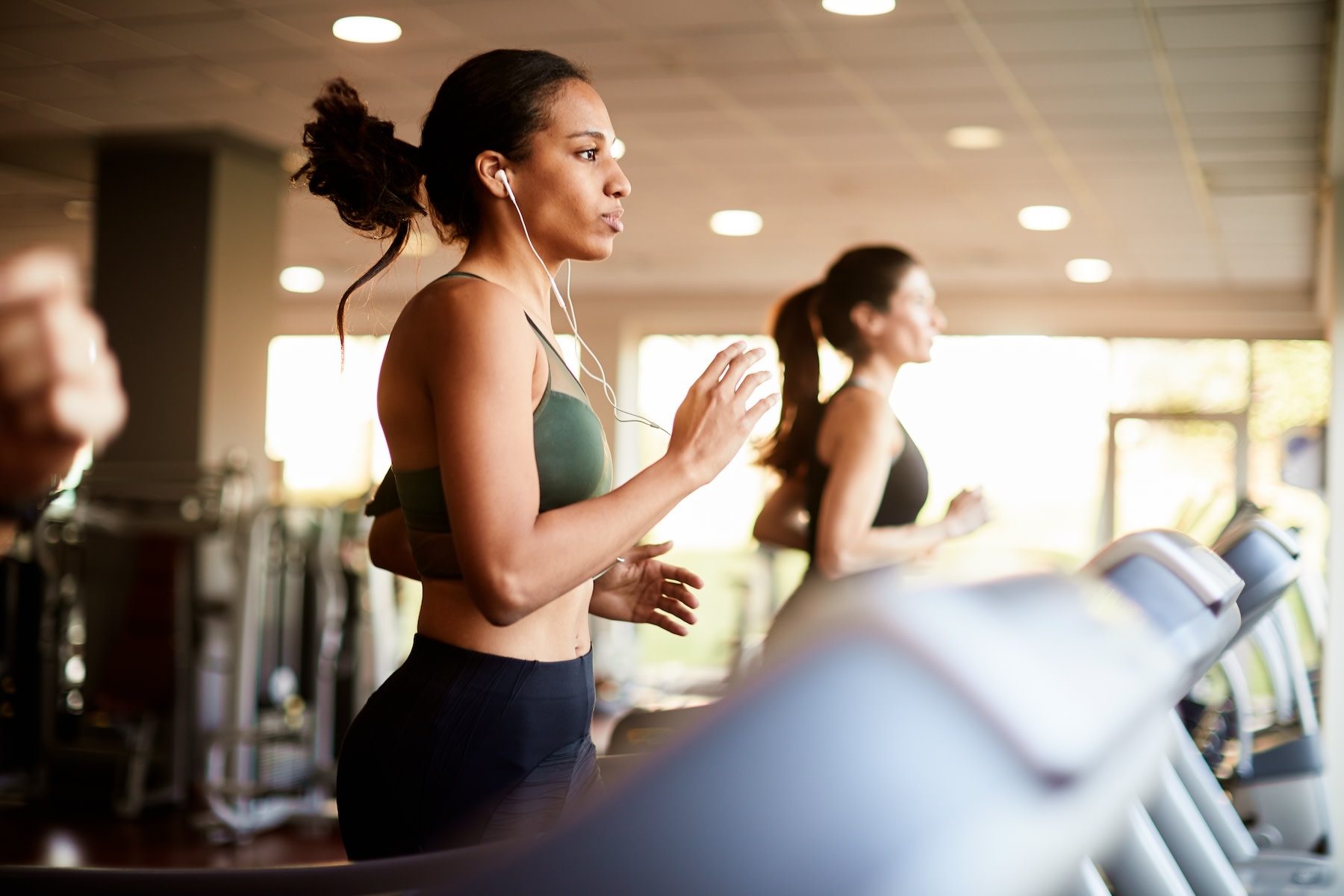
skynesher / E+ via Getty Images
Going to the Gym Alone Can Be Scary At First. Here’s How to Get Started, Fear-Free
These nine pro tips will boost your confidence and help you beat “gymtimidation.”
By Michelle Konstantinovsky•
Why Gymtimidation Is Normal
What Causes Gymtimidation?
How to Start Going to the Gym Alone
The Takeaway
If there were an adult equivalent to the first day of school, it may very well be the first day at the gym. Day one at the gym can feel like every pair of eyes is sizing you up as you walk through the door, and every whisper is about your form, your ability, or even your outfit. Despite the fact that most gym-goers are actually too focused on their own workouts to be judging yours, you may be familiar with the feeling of gym anxiety—commonly referred to as “gymtimidation”—and wonder how to start going to the gym alone when it can feel so incredibly uncomfortable.
Discover more ways to reach your goals with Peloton
For some people, walking into the gym solo can conjure up feelings of imposter syndrome or total uneasiness. According to Peloton instructor Rebecca Kennedy, you may have experienced gymtimidation if “you’ve ever had the feeling, ‘I don’t belong here’ when thinking about going to or walking into a gym—feeling overwhelmed, out of place, and nervous about what to do or being judged.”
Rather than letting fear or anxiety hinder your potential or stand in the way of having a more fun and fulfilling relationship to movement, keep reading to find expert recommendations for how to start going to the gym alone. (You’ll probably feel right at home sooner than you think.)
Why Gymtimidation Is Normal
Not only is gymtimidation or gym anxiety real, but it’s far more common than you’d expect. So common, in fact, that even your favorite Peloton instructors have dealt with it.
“Even when I first became a trainer, I felt imposter syndrome because I was still new, less experienced than other trainers, and not the strongest, fastest, or most knowledgeable,” Rebecca says. “That’s not the point of the gym, and so I did what I was always taught to do: Just do your best and keep showing up. Those feelings will fade away and those voices saying ‘I don’t belong here’ will get quieter as you get more familiar with the layout of the space, the equipment, and exercises. Soon enough, what were once strangers, intimidation, and self-doubt… become friends, confidence, and belonging.”
Like Rebecca, licensed psychotherapist and sports psychology consultant Jenn Mann, PsyD, has also experienced gymtimidation—despite the fact that she spent five years on the US Rhythmic Gymnastics National Team. “I’m always a bit intimidated by the equipment at the gym because it’s unfamiliar and I don’t usually know what setting I should use for the weight machines when I start working out,” she says.
It may be surprising to hear that lifelong athletes like Rebecca and Mann have ever struggled with anxiety at the gym, but both say gymtimidation can be a universal experience before finding a sense of security and belonging. But Rebecca makes it clear that you don’t need years of experience or a particularly early start in sports in order to eventually gain confidence and comfort working out in front of others. “Even if you didn’t grow up in the gym, it’s never too late to start,” she says. “And then you can pay it forward to the next newcomer.”

Tempura / E+ via Getty Images
What Causes Gymtimidation?
There are so many reasons why going to the gym alone can stir up uncomfortable feelings. “People who experience [gymtimidation] typically worry about not knowing how to use equipment in the gym, are concerned that people will judge their bodies, or just feel nervous in that kind of body-oriented atmosphere,” Mann says.
Some of the most common reasons for gymtimidation, according to Rebecca, include:
Being unfamiliar with the machines
Not knowing which weights to use (or how to use them)
Being unfamiliar with gym etiquette
Going to a new gym and not knowing the layout
Arriving at a busy time and feeling scared to “work into” the machines, weights, or space with other people (aka taking turns using equipment with another gym-goer)
Not seeing other people that look like you
Not having a program or specific workout to follow
Coming back from an injury
Having a past negative experience
Feeling like weights are “for men” and cardio is “for women” (not true, of course!)
Being pregnant or newly postpartum and needing a specific regimen
Comparing yourself to others and/or feeling self-conscious
How to Start Going to the Gym Alone
While gymtimidation is totally normal, it can be hard to know how to overcome it if your goal is to start confidently hitting the gym solo. It may take some time to feel completely comfortable, but the following pro tips can help you feel more prepared, inspired, and even excited to start going to the gym alone.
1. Start By Making It a Family (or Friend) Affair
Sure, the goal is to go alone, but you don’t necessarily need to dive into the deep end right away. If you’re brand new to the gym environment, starting off with a workout buddy or accountability partner can do wonders for building your confidence. Whether you bring your mom, cousin, best friend, or significant other, showing up to the gym with a close connection can help you—and your plus-one—feel safe, grounded, and ready to tackle a new adventure.
“Bring your family and get them used to the gym as a place of belonging, fun, and a good experience,” Rebecca says. “Or bring a friend as a gym buddy so you’re not alone—this could also be your accountability partner. Plus, workouts are more fun with a friend.”
The other potential advantage of having an ally by your side is the ability to pick their brain or gain wisdom if they have a bit more history in the gym. “Ask a friend who has more experience to come with you to the gym and help you get familiar with the equipment and options,” Mann says. “In general, having a workout buddy can help people be more consistent with their workouts.”
2. Get the Lay of the Land
For many, one of the scarier parts of starting a solo gym routine can be navigating a completely unfamiliar terrain. To overcome the anxiety of maneuvering around a new environment, take the time to learn about your surroundings before you start your workout.
“Walk the gym floor and get familiar with the layout,” Rebecca recommends. “Ask for a tour of your gym from the front desk staff or a trainer on duty.”
3. Learn from an Expert
A major roadblock for many new or returning exercisers—whether they’re working out at home or at the gym—is feeling totally confused or overwhelmed by options. Where do you start? Which machine is right for you? Should you even be using machines at all? By working with a trained expert, you have the advantage of building a customized plan that works for you and takes the guesswork out of your gym routine.
If you can, “get a trainer for a few sessions,” Rebecca suggests. “The goal is to learn your way around the gym; how equipment and machines work; what loads, reps, and sets are appropriate for your current fitness level; and what would be best for your goals.”
Of course, personal training sessions can be expensive. If you’re not in the position to invest in ongoing personal training sessions, inquire about complimentary guidance for newcomers. “Most gyms will give you one free training session with a professional trainer when you join,” Mann says. “Take advantage of that! When you meet with the trainer, let them know you would like them to help you create a program that you can do on your own and make sure to take notes.”
4. Try a Guided Class
If your gym offers guided classes, signing up for one can be another great way to find your footing in a new space. “If you feel intimidated or overwhelmed by the equipment, start with classes offered at the facility,” Mann suggests. “That’s a good way to become comfortable in the atmosphere and be able to get a good workout.”
Fitness classes and personal training sessions were tools that helped Rebecca feel more at ease when she experienced gymtimidation early in her training journey. “I was introduced to new equipment, exercises, and programming workouts,” she says. “I felt excited and empowered as I got stronger and felt more confident in my sense of belonging and in my body. The gym became a safe haven for me.”
5. Let Peloton Guide the Way
Just because you’re venturing out of your home and potentially away from the Peloton equipment you know and love doesn’t mean you’re totally on your own. Regardless of whether your gym has Peloton Bikes, Treads, or Rows, you can access all your favorite classes and instructors from anywhere via the Peloton App and the Peloton Strength+ App.
“Use a Peloton workout to follow so you have guidance, music, and everything you need in one space,” Rebecca says. “And use the Peloton Strength+ App that has gym-specific programs with videos demoing the movements, machines, etc. and audio tips to explain things.”
Mann says that by using the Peloton App or Peloton Strength+ App at the gym, you can find a sense of comfort in a new place thanks to the familiarity of instructors and types of workouts you’ve come to know. For example, on the Peloton App, you can explore thousands of classes across several different fitness modalities that keep you motivated through the very last rep.
Or, use the Strength+ App’s custom workout generator to create a training plan in seconds based on your fitness goals, how much time you have, your experience, and what equipment is available. The app also has instructional video clips that can help you navigate any new moves—another helpful feature for beginner and veteran gym-goers alike.
“Once you’re moving, the intimidation factor dissipates because you have a focus and a trainer guiding you,” Rebecca says. “This makes being in the gym fun, effective, and empowering.”
6. Be Open to New Connections
Sure, you may enter the gym alone, but that doesn’t mean you can’t meet new people and join a like-minded community. “Make a gym friend!” Rebecca says. “Maybe they feel the same as you, or maybe they can show you the ropes. Either way, it'll make being there feel far less intimidating right away.”
7. Embrace the Beginner Mindset
No matter where you are in your fitness journey, staying committed to learning and growing can help you keep continuously progressing. Wear your newbie identity with pride when you enter a gym for the first time, and remember that it takes time to find your groove.
“Own it!” Rebecca says. “The gym is for everyone—we are all new or beginners at some point and we learn along the way, never overnight.”
8. Start Where You Are
Maybe you played sports in school but you’ve taken a few years off from working out, or perhaps you’re someone who’s never felt comfortable in an athletic setting. No matter what your fitness level was in the past or where you’d like it to be in the future, begin working out in a way that’s appropriate for where you are now.
“Start somewhere that feels safe,” Rebecca says. “Take a class, get on a machine, and build up your confidence.”
9. Prioritize Consistency Over Intensity
There can often be a temptation to go all out when starting or restarting a fitness regimen, but hitting the gym hard as a newbie isn’t recommended, considering the risks for injuries and burnout. Instead, try to commit to a regular but realistic routine that will keep you moving and motivated.
“Go often,” Rebecca says. “The more you’re exposed to something, the more comfortable you become.”
Every exerciser is different, but as you start out, that “regular but realistic” routine might look like 15–20 minutes of movement a few times a week before gradually scaling up. (And as always, ask your doctor about what exercise regimen might be best for you.)
The Takeaway
When you’re the new kid on the block, it can be hard to remember that everyone starts as a beginner at some point. But just because going to the gym alone stirs up feelings of anxiety or “gymtimidation” doesn’t mean you’re the target of judgement or the only person who has ever struggled to work out solo in public. Most people—yes, even Peloton instructors—have felt some level of gym anxiety. But by staying consistent, asking for help, and using tools like the Peloton App and Strength+ App, you can overcome your fear of going to the gym alone and actually learn to love it.
“In order to get fluent or get good at anything, you have to be able to tolerate being a beginner and not knowing things,” Mann says. “If you can normalize this and not beat yourself up over it, then you will move past it and feel like a gym expert before you know it!”

Peloton App
Access thousands of classes with no equipment needed.
This content is for informational and educational purposes only and does not constitute individualized advice. It is not intended to replace professional medical evaluation, diagnosis, or treatment. Seek the advice of your physician for questions you may have regarding your health or a medical condition. If you are having a medical emergency, call your physician or 911 immediately.
Move your fitness journey forward
Enter your email to get articles, motivating tips, and updates from Peloton sent to your inbox.
By providing your email address, you agree to receive marketing communications from Peloton.
For more about how we use your information, see our Privacy Policy.













